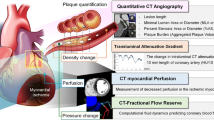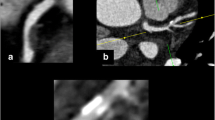Abstract
Coronary artery disease remains the leading cause of morbidity and mortality in the United States and worldwide. Morphological changes in coronary vasculature can be detected by computed tomography angiography (CTA). Besides qualitative assessment, there has been an increased utilization of quantitative assessment of plaque and stenosis on CTA. For this purpose highly standardized methods have been developed, which are sufficiently reproducible on high quality datasets on a population level. This type of analysis could be potentially useful for not only follow-up of plaque progression but also for enhancing prediction of obstructive coronary arterial lesions and has been validated against current standards such as intra vascular ultrasound, optical coherence tomography, and near-infrared spectroscopy. Studies have demonstrated that types of plaque visualized on CTA have prognostic implications. However, classification of lesions as mild, moderate, or severe might not be enough to answer the clinical question of whether or not the lesion is causing ischemia. Fractional flow reserve computed tomography (CT) and transluminal attenuation gradient are new methods, which have shown great promise in assessment of severity and functional significance of stenosis. Similarly, CT stress testing for assessment of functional significance has been found to be feasible and studies are ongoing to evaluate the accuracy of CT stress perfusion. The promise of cardiovascular CT is to potentially become a comprehensive modality in patients with suspected CAD, by combining plaque imaging, stenosis detection, and the assessment of myocardial ischemia, to provide first-line evaluation in selected patient population.




Similar content being viewed by others
References
Papers of particular interest, published recently, have been highlighted as: • Of importance •• Of major importance
•• Raff GL, Abidov A, Achenbach S, Berman DS, Boxt LM, Budoff MJ, et al. SCCT guidelines for the interpretation and reporting of coronary computed tomographic angiography. J Cardiovasc Comput Tomogr. 2009;3:122–36. Guidelines for cornonary segmentation for use in quantitative analysis of coronary atherosclerosis using CTA.
Kim SY, Kim KS, Lee YS, Lee JB, Ryu JK, Choi JY, et al. Assessment of non-calcified coronary plaques using 64-slice computed tomography: comparison with intravascular ultrasound. Kor Circ J. 2009;39:95–9.
Kitagawa T, Yamamoto H, Ohhashi N, Okimoto T, Horiguchi J, Hirai N, et al. Comprehensive evaluation of noncalcified coronary plaque characteristics detected using 64-slice computed tomography in patients with proven or suspected coronary artery disease. Am Heart J. 2007;154:1191–8.
Cademartiri F, Mollet NR, Runza G, Bruining N, Hamers R, Somers P, et al. Influence of intracoronary attenuation on coronary plaque measurements using multislice computed tomography: observations in an ex vivo model of coronary computed tomography angiography. Eur Radiol. 2005;15:1426–31.
• Rinehart S, Vazquez G, Qian Z, Murrieta L, Christian K, Voros S. Quantitative measurements of coronary arterial stenosis, plaque geometry, and composition are highly reproducible with a standardized coronary arterial computed tomographic approach in high-quality CT datasets. J Cardiovasc Comput Tomogr. 2011;5:35–43. Good article for methodology of quantitative assessment.
Voros S, Rinehart S, Qian Z, Vazquez G, Anderson H, Murrieta L, et al. Prospective validation of standardized, 3-dimensional, quantitative coronary computed tomographic plaque measurements using radiofrequency backscatter intravascular ultrasound as reference standard in intermediate coronary arterial lesions: results from the ATLANTA (assessment of tissue characteristics, lesion morphology, and hemodynamics by angiography with fractional flow reserve, intravascular ultrasound and virtual histology, and noninvasive computed tomography in atherosclerotic plaques) I study. JACC Cardiovasc Interv. 2011;4:198–208.
Brodoefel H, Burgstahler C, Sabir A, Yam CS, Khosa F, Claussen CD, et al. Coronary plaque quantification by voxel analysis: dual-source MDCT angiography vs intravascular sonography. Am J Roentgenol. 2009;192:W84–9.
Dey D, Schepis T, Marwan M, Slomka PJ, Berman DS, Achenbach S. Automated 3-dimensional quantification of noncalcified coronary plaque from coronary CT angiography: comparison with intravascular US. Radiology. 2010;257:516–22.
Boogers MJ, Broersen A, van Velzen JE, de Graaf FR, El-Naggar HM, Kitslaar PH, et al. Automated quantification of coronary plaque with computed tomography: comparison with intravascular ultrasound using a dedicated registration algorithm for fusion-based quantification. Eur Heart J. 2012;33:1007–16.
• Voros S, Rinehart S, Qian Z, Joshi P, Vazquez G, Fischer C, et al. Coronary atherosclerosis imaging by coronary CT angiography: current status, correlation with intravascular interrogation and meta-analysis. JACC Cardiovasc Imaging. 2011;4:537–48. Good review article for validation of quantitative coronary CTA against current standards.
Koo BK, Erglis A, Doh JH, Daniels DV, Jegere S , Kim HS, et al. Diagnosis of ischemia-causing coronary stenoses by noninvasive fractional flow reserve computed from coronary computed tomographic angiograms. Results from the prospective multicenter DISCOVER-FLOW (Diagnosis of Ischemia-Causing Stenoses Obtained Via Noninvasive Fractional Flow Reserve) study. J Am Coll Cardiol. 2011;58:1989–97.
Choi JH, Min JK, Labounty TM, Lin FY, Mendoza DD, Shin DH, et al. Intracoronary transluminal attenuation gradient in coronary CT angiography for determining coronary artery stenosis. JACC Cardiovasc Imaging. 2011;4:1149–57.
Chow BJ, Small G, Yam Y, Chen L, Achenbach S, Al-Mallah M, et al. Incremental prognostic value of cardiac computed tomography in coronary artery disease using CONFIRM: COroNary computed tomography angiography evaluation for clinical outcomes: an InteRnational Multicenter registry. Circ Cardiovasc Imaging. 2011;4:463–72.
Motoyama S, Kondo T, Sarai M, Sugiura A, Harigaya H, Sato T, et al. Multislice computed tomographic characteristics of coronary lesions in acute coronary syndromes. J Am Coll Cardiol. 2007;50:319–26.
Motoyama S, Sarai M, Harigaya H, Anno H, Inoue K, Hara T, et al. Computed tomographic angiography characteristics of atherosclerotic plaques subsequently resulting in acute coronary syndrome. J Am Coll Cardiol. 2009;54:49–57.
Harigaya H, Motoyama S, Sarai M, Inoue K, Hara T, Okumura M, et al. Prediction of the no-reflow phenomenon during percutaneous coronary intervention using coronary computed tomography angiography. Hear Vessel. 2011;26:363–9.
Kristensen TS, Kofoed KF, Kühl JT, Nielsen WB, Nielsen MB, Kelbæk H. Prognostic implications of nonobstructive coronary plaques in patients with non-ST-segment elevation myocardial infarction: a multidetector computed tomography study. J Am Coll Cardiol. 2011;58:502–9.
Kataoka Y, Wolski K, Uno K, Puri R, Tuzcu EM, Nissen SE, et al. Spotty calcification as a marker of accelerated progression of coronary atherosclerosis: insights from serial intravascular ultrasound. J Am Coll Cardiol. 2012;59:1592–7.
Pundziute G, Schuijf JD, Jukema JW, Boersma E, de Roos A, van der Wall EE, et al. Prognostic value of multislice computed tomography coronary angiography in patients with known or suspected coronary artery disease. J Am Coll Cardiol. 2007;49:62–70.
Lin FY, Shaw LJ, Dunning AM, Labounty TM, Choi JH, Weinsaft JW, et al. Mortality risk in symptomatic patients with nonobstructive coronary artery disease: a prospective 2-center study of 2583 patients undergoing 64-detector row coronary computed tomographic angiography. J Am Coll Cardiol. 2011;58:510–9.
Russo V, Zavalloni A, Bacchi Reggiani ML, Buttazzi K, Gostoli V, Bartolini S, et al. Incremental prognostic value of coronary CT angiography in patients with suspected coronary artery disease. Circ Cardiovasc Imaging. 2010;3:351–9.
Hulten EA, Carbonaro S, Petrillo SP, Mitchell JD, Villines TC. Prognostic value of cardiac computed tomography angiography: a systematic review and meta-analysis. J Am Coll Cardiol. 2011;57:1237–47.
Bamberg F, Sommer WH, Hoffmann V, Achenbach S, Nikolaou K, Conen D, et al. Meta-analysis and systematic review of the long-term predictive value of assessment of coronary atherosclerosis by contrast-enhanced coronary computed tomography angiography. J Am Coll Cardiol. 2011;57:2426–36.
Conflict of Interest
Usman S. Khokhar declares no conflict of interest. Anum Aslam declares no conflict of interest. Sarah Rinehart declares no conflict of interest. Szilard Voros declares no conflict of interest.
Author information
Authors and Affiliations
Corresponding author
Rights and permissions
About this article
Cite this article
Khokhar, U.S., Aslam, A., Rinehart, S. et al. Automated Coronary Plaque and Stenosis Assessment on Coronary CT Angiography: A Closer Look at Coronary Atherosclerosis. Curr Cardiovasc Imaging Rep 6, 292–299 (2013). https://doi.org/10.1007/s12410-013-9194-4
Published:
Issue Date:
DOI: https://doi.org/10.1007/s12410-013-9194-4




